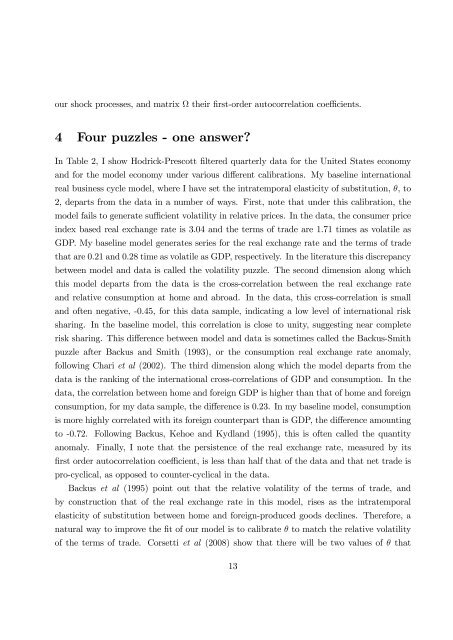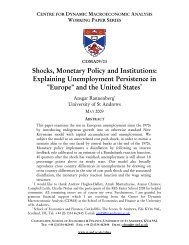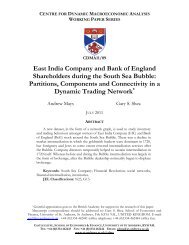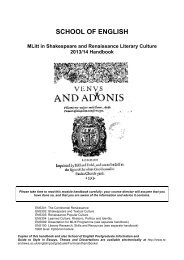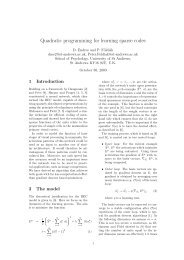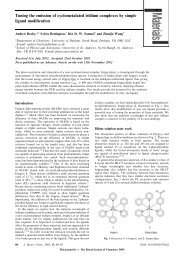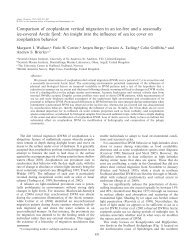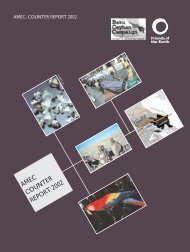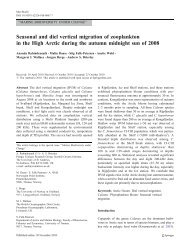Exchange rate dynamics, asset market structure and the role of the ...
Exchange rate dynamics, asset market structure and the role of the ...
Exchange rate dynamics, asset market structure and the role of the ...
You also want an ePaper? Increase the reach of your titles
YUMPU automatically turns print PDFs into web optimized ePapers that Google loves.
our shock processes, <strong>and</strong> matrix <strong>the</strong>ir …rst-order autocorrelation coe¢ cients.<br />
4 Four puzzles - one answer?<br />
In Table 2, I show Hodrick-Prescott …ltered quarterly data for <strong>the</strong> United States economy<br />
<strong>and</strong> for <strong>the</strong> model economy under various di¤erent calibrations. My baseline international<br />
real business cycle model, where I have set <strong>the</strong> int<strong>rate</strong>mporal elasticity <strong>of</strong> substitution, , to<br />
2, departs from <strong>the</strong> data in a number <strong>of</strong> ways. First, note that under this calibration, <strong>the</strong><br />
model fails to gene<strong>rate</strong> su¢ cient volatility in relative prices. In <strong>the</strong> data, <strong>the</strong> consumer price<br />
index based real exchange <strong>rate</strong> is 3.04 <strong>and</strong> <strong>the</strong> terms <strong>of</strong> trade are 1.71 times as volatile as<br />
GDP. My baseline model gene<strong>rate</strong>s series for <strong>the</strong> real exchange <strong>rate</strong> <strong>and</strong> <strong>the</strong> terms <strong>of</strong> trade<br />
that are 0.21 <strong>and</strong> 0.28 time as volatile as GDP, respectively. In <strong>the</strong> literature this discrepancy<br />
between model <strong>and</strong> data is called <strong>the</strong> volatility puzzle. The second dimension along which<br />
this model departs from <strong>the</strong> data is <strong>the</strong> cross-correlation between <strong>the</strong> real exchange <strong>rate</strong><br />
<strong>and</strong> relative consumption at home <strong>and</strong> abroad. In <strong>the</strong> data, this cross-correlation is small<br />
<strong>and</strong> <strong>of</strong>ten negative, -0.45, for this data sample, indicating a low level <strong>of</strong> international risk<br />
sharing. In <strong>the</strong> baseline model, this correlation is close to unity, suggesting near complete<br />
risk sharing. This di¤erence between model <strong>and</strong> data is sometimes called <strong>the</strong> Backus-Smith<br />
puzzle after Backus <strong>and</strong> Smith (1993), or <strong>the</strong> consumption real exchange <strong>rate</strong> anomaly,<br />
following Chari et al (2002). The third dimension along which <strong>the</strong> model departs from <strong>the</strong><br />
data is <strong>the</strong> ranking <strong>of</strong> <strong>the</strong> international cross-correlations <strong>of</strong> GDP <strong>and</strong> consumption. In <strong>the</strong><br />
data, <strong>the</strong> correlation between home <strong>and</strong> foreign GDP is higher than that <strong>of</strong> home <strong>and</strong> foreign<br />
consumption, for my data sample, <strong>the</strong> di¤erence is 0.23. In my baseline model, consumption<br />
is more highly correlated with its foreign counterpart than is GDP, <strong>the</strong> di¤erence amounting<br />
to -0.72. Following Backus, Kehoe <strong>and</strong> Kydl<strong>and</strong> (1995), this is <strong>of</strong>ten called <strong>the</strong> quantity<br />
anomaly. Finally, I note that <strong>the</strong> persistence <strong>of</strong> <strong>the</strong> real exchange <strong>rate</strong>, measured by its<br />
…rst order autocorrelation coe¢ cient, is less than half that <strong>of</strong> <strong>the</strong> data <strong>and</strong> that net trade is<br />
pro-cyclical, as opposed to counter-cyclical in <strong>the</strong> data.<br />
Backus et al (1995) point out that <strong>the</strong> relative volatility <strong>of</strong> <strong>the</strong> terms <strong>of</strong> trade, <strong>and</strong><br />
by construction that <strong>of</strong> <strong>the</strong> real exchange <strong>rate</strong> in this model, rises as <strong>the</strong> int<strong>rate</strong>mporal<br />
elasticity <strong>of</strong> substitution between home <strong>and</strong> foreign-produced goods declines. Therefore, a<br />
natural way to improve <strong>the</strong> …t <strong>of</strong> our model is to calib<strong>rate</strong> to match <strong>the</strong> relative volatility<br />
<strong>of</strong> <strong>the</strong> terms <strong>of</strong> trade. Corsetti et al (2008) show that <strong>the</strong>re will be two values <strong>of</strong> that<br />
13


